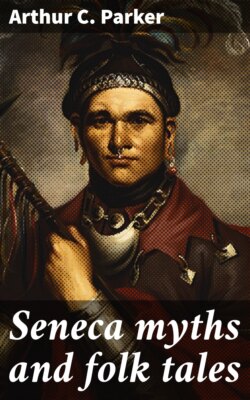Читать книгу Seneca myths and folk tales - Arthur C. Parker - Страница 11
На сайте Литреса книга снята с продажи.
STORY-TELLING CUSTOMS OF THE SENECA.
ОглавлениеTable of Contents
Among the Seneca, in common with other Iroquois tribes, each settlement had its official story tellers whose predecessors had carefully taught them the legends and traditions of the mysterious past.
According to ancient traditions, no fable, myth-tale, or story of ancient adventure might be told during the months of summer. Such practice was forbidden by “the little people” (djogĕ´on), the wood fairies. Should their law be violated some djogĕ´on flying about in the form of a beetle or bird might discover the offender and report him to their chief. Upon this an omen would warn the forgetful Indian. Failing to observe the sign some evil would befall the culprit. Bees might sting his lips or his tongue would swell and fill his mouth, snakes might crawl in his bed and choke him while he slept, and so on, until he was punished and forced to desist from forbidden talk.
Certain spirits were reputed to enforce this law for two purposes; first, that no animal should become offended by man’s boasting of his triumph over beasts, or at the same time learn too much of human cunning, and fly forever the haunts of mankind; and second, that no animal, who listening to tales of wonder, adventure or humor, should become so interested as to forget its place in nature, and pondering over the mysteries of man’s words, wander dazed and aimless through the forest. To listen to stories in the summer time made trees and plants as well as animals and men lazy, and therefore scanty crops, lean game and shiftless people resulted. To listen to stories made the birds forget to fly to the south when winter came, it made the animals neglect to store up winter coats of fur. All the world stops work when a good story is told and afterwards forgets its wonted duty in marveling. Thus the modern Iroquois, following the old-time custom, reserves his tales of adventures, myth and fable for winter when the year’s work is over and all nature slumbers.
The story teller (Hage´otă’) when he finds an audience about him or wishes to call one, announces his intention to recite a folk-tale, (gă´gāā, or in the plural, gägä‘´shon’´o‘) by exclaiming “I’´newa’eñgegĕ´odĕn, Hau’´nio‘´ djadaon “diĭnus!” The auditors eagerly reply “Hen‘´” which is the assenting to the proposed relation of the folk-tale.
At intervals during the relation of a story the auditors must exclaim “hĕn‘´.” This is the sign that they were listening. If there was no frequent response of “he,” the story teller would stop and inquire what fault was found with him or his story.
It was not only considered a breach of courtesy for a listener to fall asleep, but also a positive omen of evil to the guilty party. If any one for any reason wished to sleep or to leave the room, he must request the narrator to “tie the story,” “ensĕgägha‘´a.” Failing to say this and afterwards desiring to hear the remainder of the tale, the narrator would refuse, for if he related it at all it must be from the beginning through, unless “tied.” Thus “ĕnsĕgäha‘´a” was the magic word by which a legend might be told as a serial (from ĕnsege´odĕ).
A story teller was known as “Hage´otă’” and his stock of tales called “ganondas‘hägon”. Each listener gave the story teller a small gift, as a bead, small round brooch, beads, tobacco, or other trinket. To tell stories was called “ĕnsege´odĕn”, and the gift was termed “dagwa´niatcis,” now an obsolete word.
